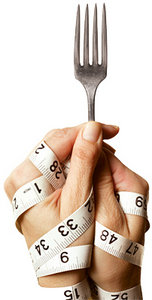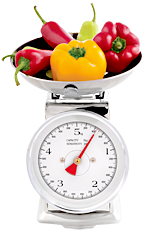The Fat You Eat Is the Fat You Wear
We don't need to eat
more low-fat foods - typically processed sweets and refined carbohydrates. We need to eat
less high-fat meat and dairy products. Why? A fat calorie is different from a calorie of protein or carbohydrate. Fat has more than double the calories of either protein or carbs. When you reduce fat consumption (meat and dairy products) from 40 percent to 20 percent, you can eat almost one-third more food, yet consume the same amount of calories.
 Your body must spend 10 times the energy to convert protein or complex carbohydrates from fruits and vegetables to body fat as it does to convert dietary fat to body fat. Only about 1 percent of protein or carbohydrates end up as body fat, because your body would rather use them up right away than waste energy to store them. So, by keeping fat consumption low, your body will store less fat.
Your body must spend 10 times the energy to convert protein or complex carbohydrates from fruits and vegetables to body fat as it does to convert dietary fat to body fat. Only about 1 percent of protein or carbohydrates end up as body fat, because your body would rather use them up right away than waste energy to store them. So, by keeping fat consumption low, your body will store less fat.
Your body only needs about 6 percent to 8 percent of calories as fat to make things like essential fatty acids, so consuming approximately 20 percent fat provides more than enough fat without giving you more than you need. It's the excessive amounts of fat in your diet that lead to excess weight, heart disease and other illness.
Mom Was Right - Always Eat Breakfast
Always eat breakfast, even if you only have time to shake up a wholesome low-fat, high-power protein and vegetable drink mix and consume it as you run out the door. (See "Drink Your Greens," March 2008 TYH.) In a study published in the Journal of Clinical Nutrition, overweight women who regularly skipped breakfast were divided into two groups. One group was asked to start eating a low-fat breakfast every morning; the other was asked to skip breakfast. After 12 weeks, the women who were eating breakfast lost significantly more weight than those who didn't. Why? A good breakfast that contains all three macronutrients - protein, fruits and vegetables and healthy oils - gives you energy and reduces your hunger during the morning, so you feel less need to grab junk food later in the day.
Follow the 80/20 Rule
 Remember, all calories are not the same. The eating plan I recommend is simple, and the 80/20 rule makes it work in the real world. Always make sure your diet is made up of at least 80 percent unrefined plant foods. You should treat processed foods, animal foods and dairy products as side dishes, contributing no more than 20 percent of your total caloric intake. If you desire these foods, use them occasionally or in very small amounts to flavor a vegetable dish.
Remember, all calories are not the same. The eating plan I recommend is simple, and the 80/20 rule makes it work in the real world. Always make sure your diet is made up of at least 80 percent unrefined plant foods. You should treat processed foods, animal foods and dairy products as side dishes, contributing no more than 20 percent of your total caloric intake. If you desire these foods, use them occasionally or in very small amounts to flavor a vegetable dish.
If you do choose to eat meat and dairy, try to consume 12 ounces or less each week of fish, white-meat chicken or turkey. Eat beef as little as possible. If you desire dairy in your diet, use only fat-free dairy such as skim milk or nonfat yogurt, and limit it to 12 ounces per week.
The great news is you can eat unlimited daily amounts of salads, raw vegetables, steamed or cooked green vegetables, beans or legumes, and fresh fruit. In addition, you can have one serving of starchy vegetables or grains daily. Using the 80/20 rule means you are allowed to eat almost any kind of food, even a small cookie or candy bar, as long as all your other calories that day are from nutrient-dense, plant-based vegetation.
Keep in mind that being overweight is primarily due to how much fat you eat. Most fat comes from animal products, full-fat dairy products or oils. Oils are liquid fat; therefore, the more oil you consume, the more weight you will gain. Eat foods that are very low in fat and high in complex carbohydrates and fiber (fruits and vegetables). Avoid foods from animals as much as possible because they are high in fat and low in complex carbohydrates and fiber.
Donald L. Hayes, DC, graduated from Western States Chiropractic College in 1977 and is the author of five health and wellness books including his latest, Weight Loss to Wellness. To learn more, visit www.greensfirst.com.

